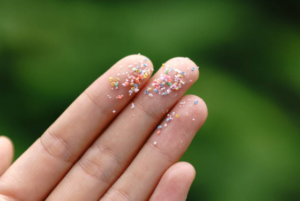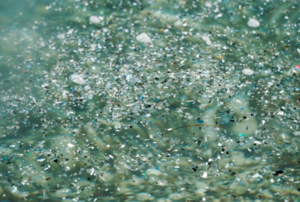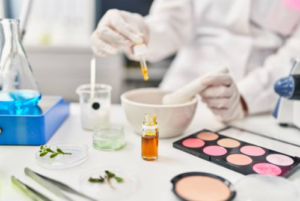How the Industry is Addressing Pollution

In the ever-evolving landscape of beauty and skincare, a silent but potent contributor to environmental degradation has emerged—microplastics. These tiny particles, often found in exfoliating scrubs, cleansers, and other personal care products, have been wreaking havoc on our oceans, wildlife, and even our own health. The beauty industry, recognizing the need for change, is now spearheading a movement to ban microplastics. In this blog, we’ll delve into the beauty of this ban, exploring how the industry is addressing pollution and fostering a more sustainable and responsible approach to beauty.
Microplastics can be broadly categorized into two main types: primary microplastics and secondary microplastics.
- Primary Microplastics: These are intentionally manufactured tiny plastic particles that are added to personal care products for specific purposes. In the beauty industry, primary microplastics are commonly used as exfoliating agents in scrubs and cleansers. These particles are designed to slough off dead skin cells and impurities from the skin’s surface.
- Secondary Microplastics: Unlike their intentionally crafted counterparts, secondary microplastics originate from the breakdown of larger plastic items, such as packaging, that disintegrate over time due to environmental factors like sunlight and water. These microplastics find their way into beauty products indirectly, as a result of the fragmentation of larger plastic debris.
The Environmental Impact
As the beauty industry’s love affair with microplastics continues, the environmental consequences have unfolded on a grand scale. The seemingly innocent exfoliating beads and abrasive particles that promise smoother skin are, in reality, leaving an indelible mark on our planet. Understanding the profound environmental impact of microplastics requires delving into the intricacies of their journey from bathroom drains to the far-reaching corners of our oceans.
- Waterways as Conduits:Microplastics, once washed down the drain, embark on a perilous journey through waterways. These particles, too small to be captured by conventional water treatment systems, flow seamlessly into rivers and streams, serving as stealthy conduits for the transportation of environmental pollutants.
- Oceanic Infiltration:The ultimate destination for many microplastics is the vast expanse of our oceans. As they merge into marine ecosystems, the impact on aquatic life becomes profound. The beauty industry’s contribution to the plastic soup in our oceans has become a significant concern, with estimates suggesting that microplastics could outnumber fish in the ocean by 2050 if current trends persist.
- Disruption of Aquatic Ecosystems:The introduction of microplastics into aquatic environments sets off a chain reaction that disrupts the delicate balance of marine ecosystems. From the smallest organisms to the largest marine mammals, no corner of the ocean is immune to the adverse effects of these tiny invaders.
- Bioaccumulation and Biomagnification:One of the most alarming aspects of microplastic pollution is the phenomenon of bioaccumulation and biomagnification. Small marine organisms, such as plankton and filter-feeders, consume microplastics, mistaking them for food. As larger predators feed on these smaller organisms, the concentration of microplastics increases, resulting in biomagnification up the food chain.
- Impacts on Biodiversity:The intricate web of life in our oceans is under threat due to the presence of microplastics. From coral reefs to the deep abyss, marine biodiversity faces a perilous future as these particles infiltrate and interfere with the natural behaviors and reproductive cycles of marine species.
- Persistent Pollutants:Unlike natural substances that break down over time, microplastics persist in the environment for an extended duration. Their longevity exacerbates the problem, as they continue to circulate in ecosystems, causing harm long after they are introduced.
- Microplastics in Sediments:The journey of microplastics doesn’t end with their presence in the water column; many settle into sediments, further impacting benthic organisms and altering sediment composition. This sedimentary reservoir of microplastics serves as a lasting legacy of our disposable culture.
- Land-Based Sources:Microplastics also find their way into aquatic environments through runoff from land-based sources. Urban areas, agricultural fields, and industrial zones contribute to the contamination of water bodies with these insidious particles.
- Ecosystem Services at Risk:The degradation of marine ecosystems due to microplastic pollution puts essential ecosystem services at risk. From fisheries to coastal protection, the services that oceans provide to humanity are compromised, affecting livelihoods and the well-being of communities dependent on marine resources.

The Beauty Industry’s Wake-Up Call
In the glossy realm of beauty, where the pursuit of perfection often overshadows environmental considerations, the industry has been confronted with an undeniable wake-up call – the pervasive and destructive impact of microplastics. This section explores how the beauty industry has come to recognize its role in the microplastic crisis, sparking a profound shift toward sustainability and a heightened sense of responsibility.
- Facing the Microplastic Dilemma:The realization that microplastics, once hailed for their exfoliating prowess, were contributing to environmental degradation marked a pivotal moment for the beauty industry. The industry had to confront the uncomfortable truth that its products, designed to enhance beauty, were inadvertently tarnishing the planet.
- Reassessing Formulations:As the microplastic predicament gained prominence, beauty brands faced the challenge of reassessing their formulations. The use of microplastics in exfoliating products, long celebrated for their effectiveness, came under scrutiny, prompting a reevaluation of ingredients and a quest for more sustainable alternatives.
- Commitment to Sustainability:A growing number of beauty brands responded to the wake-up call with a resounding commitment to sustainability. This commitment extended beyond the elimination of microplastics, encompassing a holistic approach to responsible sourcing, eco-friendly packaging, and cruelty-free practices.
- Innovations in Formulation:The beauty industry embarked on a journey of innovation to find suitable replacements for microplastics in exfoliating products. Natural alternatives such as finely ground seeds, nuts, and minerals gained popularity for their effectiveness without the environmental repercussions associated with microplastics.
- Public Scrutiny and Brand Accountability:The era of increased connectivity and information dissemination placed beauty brands under a microscope. Consumers, armed with knowledge about the environmental impact of microplastics, began holding brands accountable for their practices. Public scrutiny became a driving force for change, compelling brands to prioritize sustainability or risk losing consumer trust.
- Collaborative Initiatives:Recognizing the complexity of the microplastic issue, some beauty brands joined forces with environmental organizations and research institutions to foster collaborative initiatives. These partnerships aimed at advancing research, raising awareness, and collectively finding solutions to mitigate the industry’s impact on the environment.
- Educational Campaigns:In addition to reformulating products, some beauty brands took a proactive approach by launching educational campaigns. These initiatives aimed to inform consumers about the environmental impact of microplastics, encouraging them to make informed choices and fostering a sense of shared responsibility.
- Adapting to Regulatory Changes:Governments and regulatory bodies began responding to the microplastic crisis by introducing measures to restrict or ban the use of microplastics in personal care products. The beauty industry, in turn, had to adapt to these regulatory changes, further accelerating the shift toward cleaner, more sustainable practices.
- Transparency as a Standard:Transparency became a key tenet of responsible beauty practices. Brands that embraced transparency not only disclosed their formulations but also shared information about their sustainability initiatives, sourcing practices, and efforts to minimize environmental impact.

The Rise of Microplastic-Free Certifications
While the focus has largely been on eliminating microplastics from formulations, the beauty industry is also addressing the environmental impact of packaging. Many brands are shifting toward biodegradable and eco-friendly packaging options, reducing the overall ecological footprint of their products. This holistic approach aligns with the industry’s commitment to sustainability and its recognition that true beauty extends beyond the product itself.
Consumers are becoming increasingly conscious of the products they use and their environmental impact. In response to this demand for transparency, several organizations have introduced microplastic-free certifications. These certifications serve as a beacon for consumers, guiding them toward products that adhere to strict standards, ensuring that neither the formulation nor the packaging contains harmful microplastics.
Several beauty brands have embraced the challenge of eliminating microplastics from their products and are leading the charge toward a cleaner, more sustainable industry. One such pioneer is The Clean Beauty Company, which has not only banned microplastics but also initiated campaigns to raise awareness about the impact of plastic pollution. Their commitment extends beyond product formulation, encompassing sustainable sourcing, cruelty-free practices, and eco-friendly packaging.
Empowering consumers with knowledge is a crucial aspect of the beauty industry’s quest to address pollution. By providing information about the environmental impact of microplastics and offering alternatives, brands are not just selling products but fostering a sense of responsibility among their customers. This educational approach is fostering a new era of conscious consumers who are making informed choices that align with their values.
Recognizing the severity of the microplastic problem, some governments are taking regulatory measures to curb its impact. Legislation banning or restricting the use of microplastics in personal care products has been enacted in various regions, compelling the beauty industry to adapt and innovate. While these regulations present challenges, they also provide an opportunity for the industry to showcase its commitment to sustainability.
While the movement to ban microplastics is gaining momentum, challenges persist. Formulating effective and sustainable alternatives requires research and innovation. The beauty industry is rising to the occasion, investing in research and development to create products that not only meet consumer expectations but also adhere to stringent environmental standards.

Additionally, the shift to sustainable practices may present economic challenges for some businesses, particularly smaller brands with limited resources. However, the industry’s response to these challenges is indicative of a broader commitment to creating a positive impact on the planet.
The beauty of banning microplastics lies in the transformative power it holds for the beauty industry and the planet. This movement is more than just a trend; it’s a paradigm shift toward a more responsible and sustainable approach to beauty. As consumers become increasingly mindful of the environmental impact of their choices, the beauty industry is not merely adapting; it’s leading the way toward a future where beauty is synonymous with ethical and ecological responsibility. Together, as conscious consumers and conscientious brands, we can redefine beauty standards and contribute to a world where every skincare routine is a step toward a cleaner, healthier planet.




